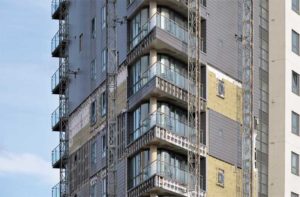Structural Requirements of the Air Barrier Explained

by Rick Quirouette, B.Arch.
In 1980, the author, an officer of the Institute for Research in Construction (IRC) of the National Research Council of Canada (NRCC), was invited by a large Canadian construction company to investigate the cause of the continuing building envelope deficiencies in the construction of commercial, institutional, industrial buildings in Canada.
The deficiencies reported by the construction industry included, “… no matter how we construct building envelopes they continue to fail in early occupancy, with rain penetration, condensation damage, high energy losses, temperature control and more.”
During the six-month study, over 30 large projects under construction were visited throughout western Canada. The review eventually determined the cause of most deficiencies in the early occupancy of new buildings, a fundamental gap in building envelope science, a misinterpretation of the vapour barrier requirement as defined by the National Building Code of Canada (NBCC). The vapour barrier requirement of the NBCC were clear enough and accurate. The industry including building officials misinterpreted the vapour barrier requirement as air leakage control for the building envelope. The sad fact was no matter how well a vapour barrier was built, it could never function adequately without due consideration of the structural requirements for the air barrier system. The findings were controversial at first but were eventually incorporated in the next edition of the NBCC.
In 1985, the NBCC introduces, the ‘air barrier requirements,’ separate and distinct from the vapour barrier requirements.
SECTION 5.3 CONTROL OF AIR LEAKAGE SUB-SECTION
5.3.1. AIR BARRIERS 5.3.1.1.(1)
Where a building assembly will be subjected to a temperature differential, a differential in water vapour pressure and a differential in air pressure due to stack effect, mechanical systems or wind, the assembly shall be designed to provide an effective barrier to air exfiltration and infiltration, at a location that will prevent condensation within the assembly, through
(a) the materials of the assembly,
(b) joints in the assembly,
(c) joints in components of the assembly, and
(d) junctions with other building elements.
The introduction of this new requirement was a first in Canada and North America. It was originally slated for inclusion in the structural code of NBCC, Part 4, as a structural requirement but eventually attached to Part 5 WIND, WATER AND VAPOUR PROTECTION of NBCC. As one can see, it was rudimentary but included the essential criteria for air leakage control including barriers to:
1-“…air exfiltration and infiltration,” and
2-“…a differential in air pressure due to stack effect, mechanical systems or wind.”
Unfortunately, the application of the 1985 NBCC requirement for the air barrier system was never fully realized or correctly implemented. The problem is the lack of professional consideration for the structural requirements of an air barrier system.
The air barrier is an assembly of materials and it has a special purpose. Not only does it control air leakage, but it reduces insulation heat loss/gain, limits condensation and moisture damages, reduces rain penetration, and supports noise control and fire protection measures. It should be designed and constructed with the two following functions in mind.







